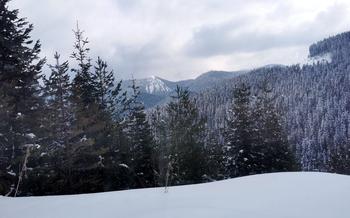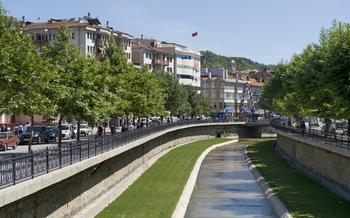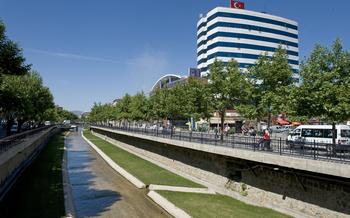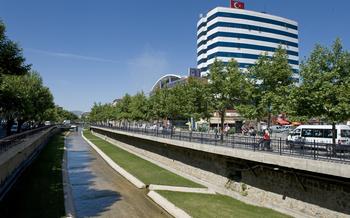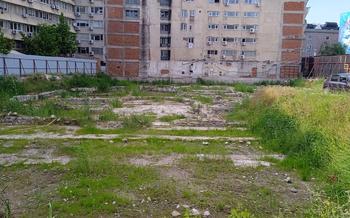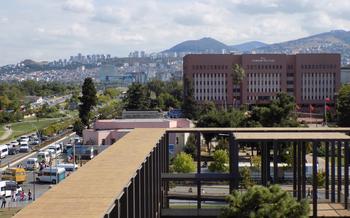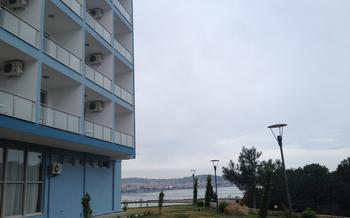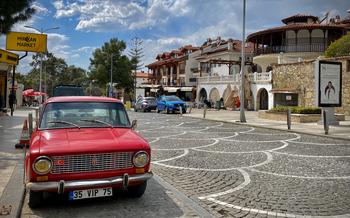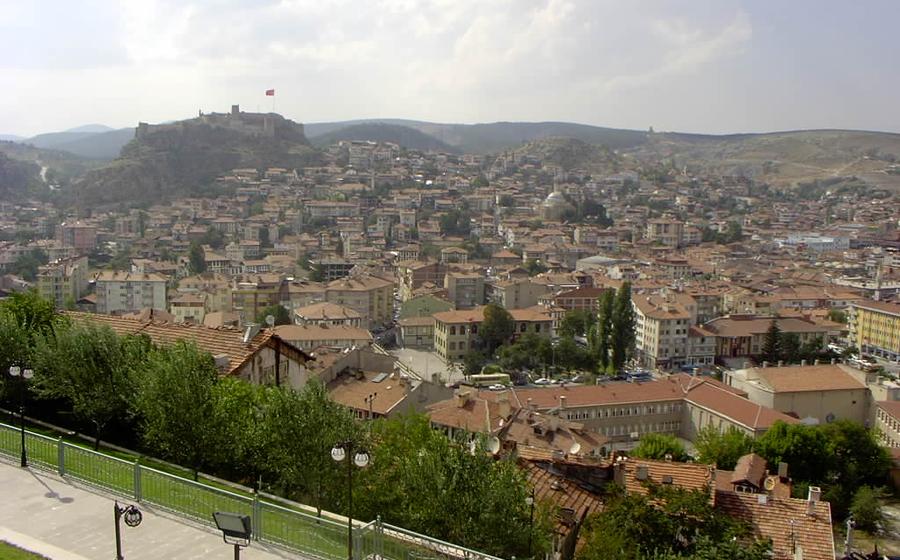
Küre Mountains Abana Coastal Park
- History of the Küre Mountains National Park
- Geographical Features
- Biodiversity: A Realm of Richness and Conservation
- Hiking and Trekking
- Camping and Accommodation
- Picnicking and Barbecuing: A Culinary Adventure in Nature's Embrace
- Birdwatching and Wildlife Viewing
- Fishing and Angling
- Boating and Canoeing: Embracing the Tranquil Waters of the Küre Mountains
- Cultural Heritage and Local Traditions:
- Gastronomy and Local Cuisine
- Photography Opportunities
- Accessibility and Transportation
- Practical Tips:
- Safety and Regulations
- Insider Tip: Uncover the Hidden Gem of Çatak Canyon
History of the Küre Mountains National Park
The Küre Mountains National Park is a treasure trove of historical significance, boasting a rich tapestry of ancient ruins and artifacts that tell the tale of civilizations past. Nestled amidst its breathtaking landscapes, visitors can embark on a journey through time, discovering remnants of bygone eras.
The park's historical roots trace back to the ancient Greek city of Cytorum, founded in the 7th century BC. Its strategic location at the crossroads of trade routes made it a thriving center of commerce and culture. Excavations have unearthed impressive ruins, including temples, theaters, and fortifications, offering a glimpse into the grandeur of this once-prosperous city.
Over the centuries, the region fell under the rule of various empires, including the Romans, Byzantines, and Ottomans, each leaving their own unique mark on the landscape. From Roman aqueducts to Ottoman bridges, the park is dotted with relics of these diverse civilizations.
One of the most intriguing aspects of the park's history is the legend of the "Lost City of Gold." According to local folklore, a hidden treasure lies buried somewhere within the Küre Mountains, waiting to be discovered by a fortunate adventurer. While the existence of the treasure remains a mystery, the legend adds an air of excitement and intrigue to the park's already rich history.
From a geological perspective, the Küre Mountains were formed millions of years ago as a result of tectonic plate movements. The region's unique topography, characterized by towering peaks, deep valleys, and cascading waterfalls, is a testament to the powerful forces that shaped this magnificent landscape.
Geographical Features
The Küre Mountains National Park boasts a diverse array of geographical features that contribute to its stunning beauty and ecological significance. Towering cliffs, carved by centuries of erosion, form dramatic backdrops to the park's landscapes. Deep canyons, formed by the erosive power of rivers, provide a glimpse into the geological history of the region. The park is also home to numerous rivers and waterfalls, which cascade through the mountains, creating a symphony of sound and movement.
The park's diverse topography gives rise to a variety of ecosystems, each with its own unique flora and fauna. Lush forests, dominated by towering oak, beech, and pine trees, cover the mountain slopes. In contrast, open meadows, dotted with wildflowers, provide a habitat for a variety of insects, birds, and small mammals. Wetlands, such as marshes and bogs, support a rich diversity of aquatic plants and animals, including frogs, turtles, and waterfowl.
The Küre Mountains National Park's geographical features are not only visually stunning but also scientifically significant. The park's cliffs and canyons provide valuable insights into the geological processes that have shaped the region over millions of years. The park's diverse ecosystems serve as natural laboratories for studying the complex interactions between plants, animals, and their environment.
To fully appreciate the park's geographical diversity, visitors can embark on one of the many hiking trails that wind through the mountains and valleys. These trails offer breathtaking views of the park's landscapes and provide opportunities to explore its various ecosystems. Visitors can also visit the park's information center to learn more about the park's geology, ecology, and history.
Biodiversity: A Realm of Richness and Conservation
The Küre Mountains National Park teems with an extraordinary diversity of flora and fauna, showcasing Turkey's rich natural heritage. Home to over 1,200 plant species, the park boasts an array of habitats, from lush forests to alpine meadows and wetlands, each supporting a unique assemblage of plant life.
Among the park's botanical wonders are rare and endangered species, including the Kastamonu fir, a majestic conifer found exclusively in this region. Its towering presence adds to the park's allure, while its conservation status highlights the importance of preserving these unique species for future generations.
The park's fauna is equally diverse, with over 300 bird species recorded, including migratory birds that grace the skies during their seasonal journeys. Birdwatchers can delight in spotting eagles soaring above the peaks, colorful songbirds flitting through the trees, and the occasional glimpse of a rare vulture or owl.
Conservation efforts are a cornerstone of the park's management, ensuring the protection of its biodiversity. Habitat restoration projects, wildlife monitoring programs, and public awareness campaigns are among the initiatives undertaken to maintain the ecological integrity of this natural treasure.
Visitors to the Küre Mountains National Park have the opportunity to witness the wonders of biodiversity firsthand, while also contributing to its conservation through responsible tourism practices. By respecting wildlife, staying on designated trails, and supporting local conservation efforts, travelers can play a vital role in preserving this extraordinary natural heritage for generations to come.
Hiking and Trekking
The Küre Mountains National Park offers a diverse range of hiking trails catering to hikers of all skill levels. From leisurely strolls along riverbanks to challenging treks through dense forests and rugged mountain terrain, there's something for every nature enthusiast.
Mesmerizing Views and Scenic Spots:
Embark on a journey through breathtaking landscapes as you follow the well-marked trails. The park's varied topography reveals stunning panoramic views of lush forests, shimmering rivers, cascading waterfalls, and distant mountain peaks. Each trail offers unique vistas and photo opportunities, making every hike a visual feast.
Theoretical Knowledge for Safe Hiking:
Before hitting the trails, familiarize yourself with essential hiking safety guidelines. Learn about proper navigation techniques, including map reading and compass use. Understand the importance of staying on designated trails to minimize your impact on the environment and avoid disturbing wildlife. Always be prepared for changing weather conditions by carrying appropriate clothing and gear.
Practical Tips for a Rewarding Hike:
Choose the right trail for your fitness level and experience. Start with shorter, easier trails if you're a beginner and gradually work your way up to more challenging routes. Pack plenty of water, snacks, and energy bars to keep your energy levels up during the hike. Wear comfortable, well-fitting hiking shoes to prevent blisters and ensure a safe and enjoyable trek.
Camping and Accommodation
Within the Küre Mountains National Park, designated camping areas offer a range of options for visitors seeking an immersive experience in nature. These campsites are equipped with essential facilities like restrooms, water sources, and fire pits, ensuring a comfortable stay.
For those seeking a more luxurious experience, alternative accommodation options abound near the park. Hotels, guesthouses, and eco-lodges offer a variety of amenities, from cozy rooms to private cabins, catering to different preferences and budgets.
Sustainable camping practices are paramount to preserving the park's pristine environment. Visitors are encouraged to adhere to leave-no-trace principles, minimizing their impact on the ecosystem. Proper waste disposal, responsible campfire management, and respecting wildlife habitats are crucial aspects of sustainable camping.
Choosing the right campsite is essential for a pleasant experience. Factors to consider include proximity to desired attractions, availability of desired facilities, and personal preferences for privacy or social interaction.
Setting up camp requires careful planning. Arriving early to secure a desirable spot, leveling your tent on a flat surface, and securing your gear against strong winds are important steps for a comfortable and safe stay.
Picnicking and Barbecuing: A Culinary Adventure in Nature's Embrace
Whether you prefer the tranquil sound of a flowing river or the rustling leaves of a dense forest, the Küre Mountains National Park offers a plethora of designated picnic areas that cater to every taste. These idyllic spots provide a perfect setting to reconnect with nature and indulge in a culinary feast amidst breathtaking scenery.
Designated Picnic Areas: A Haven for Outdoor Enthusiasts
The park's designated picnic areas are strategically located throughout its diverse landscapes, ensuring that you can find the perfect spot to suit your preferences. Whether you seek the shade of towering trees or the open expanse of a meadow, these designated zones offer ample space for spreading out your blanket and setting up your feast.
Essential Facilities for a Comfortable Experience
To enhance your picnicking experience, the park authorities have thoughtfully provided essential facilities at each designated area. Picnic tables, grills, and restrooms are readily available, ensuring that you have everything you need for a comfortable and enjoyable day outdoors.
Responsible Picnicking: A Commitment to Sustainability
As you savor the delights of your picnic, remember that responsible picnicking is crucial for preserving the pristine beauty of the park. Dispose of your waste properly in the designated bins to minimize environmental impact and maintain a clean and healthy environment for all visitors.
Practical Tips for a Perfect Picnic
To make your picnic a truly memorable experience, consider these practical tips:
- Plan Ahead: Prepare your picnic menu in advance, considering dietary preferences and allergies among your group. Pack a variety of snacks, sandwiches, fruits, and beverages to cater to everyone's tastes.
- Pack Smart: Bring reusable containers, utensils, and napkins to reduce waste. Don't forget a cooler to keep your food and drinks fresh and chilled.
- Choose Your Spot Wisely: Arrive early to secure the best picnic spot, especially during peak season. Consider factors such as shade, proximity to water, and the surrounding scenery.
- Respect Wildlife: While enjoying your picnic, be mindful of the park's wildlife. Avoid feeding animals, as it can disrupt their natural behavior and diet.
- Leave No Trace: When it's time to leave, ensure you clean up your picnic area thoroughly. Dispose of all trash properly and leave the site as pristine as you found it.
Birdwatching and Wildlife Viewing
The Küre Mountains National Park is a haven for bird enthusiasts, with over 250 species recorded within its boundaries. The park's diverse habitats, ranging from forests and meadows to wetlands and cliffs, provide a home to a wide variety of birds, including migratory species and rare raptors. Some of the most notable bird species found in the park include the golden eagle, the imperial eagle, the booted eagle, the lesser spotted eagle, the short-toed snake eagle, the Bonelli's eagle, the Eurasian eagle-owl, the long-eared owl, the short-eared owl, the little owl, the scops owl, the Eurasian wryneck, the middle spotted woodpecker, the lesser spotted woodpecker, the Syrian woodpecker, the great spotted woodpecker, the green woodpecker, the black woodpecker, the European roller, the European bee-eater, the Eurasian hoopoe, the common kingfisher, the grey-headed woodpecker, the Syrian woodpecker, the lesser spotted woodpecker, the middle spotted woodpecker, the great spotted woodpecker, the green woodpecker, the black woodpecker, the hawfinch, the corn bunting, the cirl bunting, the rock bunting, the snowfinch, the twite, the linnet, the goldfinch, the siskin, and the crossbill.
For birdwatchers, the best spots to visit in the park include the bird blind near the visitor center, the observation tower overlooking the lake, and the hiking trails that wind through the forest. These areas offer excellent opportunities to spot a variety of bird species, including migratory birds during the spring and autumn seasons.
Tips for Birdwatching in the Küre Mountains National Park:
- Bring binoculars and a field guide to help you identify the different bird species.
- Be patient and observant, as birds can be easily spooked.
- Avoid making loud noises or sudden movements.
- Stay on the designated trails to minimize disturbance to the birds.
- Respect the birds' natural habitats and do not leave any litter behind.
Fishing and Angling
The Küre Mountains National Park is a haven for fishing enthusiasts, offering a diverse range of fish species in its pristine rivers and lakes. Anglers can cast their lines for trout, carp, bass, and other freshwater fish, enjoying the tranquility of the natural surroundings. Designated fishing areas are available within the park, ensuring that anglers can pursue their passion while respecting the park's ecosystems.
Fishing permits are required for all anglers, and regulations regarding catch limits and fishing methods are in place to ensure the sustainability of the fish populations. Catch-and-release practices are encouraged to minimize the impact on the delicate aquatic ecosystems.
To enhance your fishing experience, consider hiring a local guide who can provide valuable insights into the best fishing spots, techniques, and bait selection. Guided fishing tours are also available, allowing visitors to explore remote and secluded areas of the park's waterways.
Whether you're a seasoned angler or a beginner looking to try your hand at fishing, the Küre Mountains National Park offers an unforgettable experience amidst breathtaking scenery. So, pack your fishing gear, immerse yourself in the tranquility of nature, and enjoy the thrill of reeling in a catch in this pristine wilderness.
Boating and Canoeing: Embracing the Tranquil Waters of the Küre Mountains
The Küre Mountains National Park is a haven for water enthusiasts, offering a serene and picturesque setting for boating and canoeing adventures. Glide along the tranquil waters of the park's rivers and lakes, surrounded by breathtaking landscapes and vibrant ecosystems.
Whether you're a seasoned paddler or a novice looking for a leisurely excursion, the park provides a range of opportunities to explore its aquatic wonders. Several rental services and guided tours are available, catering to different skill levels and preferences.
Theoretical Aspects: Safety, Navigation, and Aquatic Ecosystems
Before embarking on your boating or canoeing excursion, it's essential to prioritize safety and respect for the park's delicate aquatic ecosystems. Familiarize yourself with basic safety guidelines, including proper paddling techniques, wearing appropriate safety gear, and being aware of potential hazards such as strong currents or changing weather conditions.
Understanding navigation is crucial for a safe and enjoyable paddling experience. Learn how to read maps and charts, identify landmarks, and navigate using a compass or GPS device.
Respecting aquatic ecosystems is paramount. Minimize your impact on the environment by avoiding disturbing wildlife, using eco-friendly sunscreen and insect repellent, and properly disposing of waste.
Practical Tips for a Memorable Boating or Canoeing Experience
When choosing a watercraft, consider your skill level and the intended route. Kayaks and canoes offer different paddling experiences, and choosing the right one can enhance your enjoyment.
Pack essential items such as a first-aid kit, water, snacks, sunscreen, and a hat. Consider bringing a camera to capture the stunning scenery and wildlife encounters.
Plan your route carefully, taking into account factors such as distance, paddling conditions, and points of interest. The park's visitor center can provide valuable information and advice on choosing the most suitable route for your abilities and interests.
Cultural Heritage and Local Traditions:
The Küre Mountains National Park is not only a natural paradise but also a region steeped in rich cultural heritage and vibrant local traditions. Visitors to the park can explore ancient settlements, traditional villages, and historical sites that offer a glimpse into the region's fascinating past.
One of the highlights of the park is the Ilıca Village, renowned for its well-preserved Ottoman-era houses and cobblestone streets. Visitors can wander through the village, admiring the traditional architecture, and interact with the friendly locals who are known for their warm hospitality.
The region is also home to several traditional festivals and celebrations that showcase the local culture and traditions. The Küre Mountains Honey Festival, held annually in August, is a vibrant event that celebrates the region's renowned honey production. Visitors can sample a variety of honey products, witness traditional beekeeping demonstrations, and enjoy local music and dance performances.
Another must-experience cultural tradition is the "Kilim" weaving, a centuries-old craft practiced by the local women. Visitors can visit the village of Ovacık to witness the intricate process of weaving these colorful rugs and purchase unique handmade souvenirs.
By embracing the cultural heritage and local traditions of the Küre Mountains National Park, visitors can gain a deeper understanding of the region's history, customs, and way of life, creating a truly immersive and enriching travel experience.
Gastronomy and Local Cuisine
The gastronomy of Kastamonu, rooted in its rich history and diverse cultural influences, offers a delightful culinary journey for food enthusiasts. Local dishes showcase fresh, seasonal ingredients, often sourced directly from the region's farms and orchards. Traditional recipes, passed down through generations, reflect the harmonious blend of Turkish, Ottoman, and regional traditions.
Must-Try Dishes:
- Kastamonu Tandır Kebabı: Tender lamb meat slow-cooked in a traditional clay oven, known as tandır, resulting in a succulent and flavorful dish.
- Geleneksel Pide: A traditional flatbread topped with various fillings, such as cheese, minced meat, or vegetables, showcasing the region's mastery of breadmaking.
- Çöven: A hearty stew made with white beans, vegetables, and meat, often served with rice or bread, embodying the essence of home-style cooking.
Local Delicacies:
- Kastamonu Ekmeği: A unique type of bread, characterized by its thin and crispy texture, often enjoyed with local cheeses and honey.
- Ağız Çöreği: A sweet pastry filled with walnuts and honey, a beloved treat among locals and visitors alike.
- Cevizli Sucuk: A local specialty made from walnuts strung together on a thread and dipped in grape molasses, resulting in a sweet and savory confection.
Supporting Local Food Producers:
- Farmers' Markets: Visit local farmers' markets to support the region's agricultural heritage and purchase fresh produce, dairy products, and homemade delicacies.
- Local Restaurants: Dine at local restaurants that celebrate traditional recipes and source their ingredients from local suppliers, contributing to the sustainability of the region's food system.
- Cooking Classes: Immerse yourself in the local culinary culture by participating in cooking classes, learning the art of preparing traditional dishes using local ingredients.
Respecting Food Customs:
- Meal Etiquette: Observe local customs and meal etiquette, such as removing shoes before entering a home and waiting for your host's invitation to eat.
- Food Sharing: Embrace the Turkish tradition of sharing food, often served in communal plates, fostering a sense of camaraderie and hospitality.
- Respect for Halal: Be mindful of the Islamic dietary restrictions and respect halal practices, ensuring that the food you consume adheres to these guidelines.
Photography Opportunities
The Küre Mountains National Park is a haven for photographers, offering a plethora of stunning landscapes, diverse wildlife, and rich cultural scenes that are just begging to be captured. Whether you're an amateur enthusiast or a seasoned professional, the park provides endless opportunities to unleash your creativity and capture breathtaking images.
Theoretical Knowledge:
-
Photography Ethics: Respect wildlife and minimize disturbance. Use telephoto lenses to photograph animals from a distance without causing stress or altering their behavior.
-
Composition Techniques: Learn the principles of composition, such as the rule of thirds, leading lines, and negative space, to create visually appealing and balanced images.
-
Lighting Conditions: Understand how different lighting conditions, such as golden hour and blue hour, can dramatically affect the mood and tone of your photographs.
Practical Advice:
-
Camera Equipment: Choose the right camera and lens combination for your needs. A DSLR or mirrorless camera with a wide-angle lens is ideal for capturing vast landscapes, while a telephoto lens is essential for wildlife photography.
-
Post-Processing: Utilize photo editing software to enhance your images, adjust colors, and remove distractions. However, avoid over-editing and maintain the authenticity of the scene.
-
Local Knowledge: Engage with local photographers or guides who can provide valuable insights into the best spots for photography and help you understand the local culture and traditions.
Accessibility and Transportation
Getting to the Küre Mountains National Park is relatively easy, with several transportation options available. For those without their own vehicles, public transportation is a viable option, with regular bus services connecting major cities to the park's entrance. Driving is also a convenient choice, with well-maintained roads leading directly to the park. The park's accessibility makes it an ideal destination for visitors of all abilities, including those with disabilities or special needs.
When planning your journey, consider opting for sustainable transportation methods to minimize your carbon footprint. Public transportation and carpooling are excellent options for reducing individual vehicle emissions. By choosing environmentally friendly transportation, you can contribute to the preservation of the park's natural beauty and support sustainable tourism practices.
Practical Tips:
- Plan your journey in advance to ensure smooth transportation arrangements.
- Check bus schedules and routes to avoid any inconvenience or delays.
- If driving, be mindful of the winding roads and adhere to speed limits for a safe journey.
- Consider carpooling or using public transportation to reduce your carbon footprint and contribute to sustainable tourism.
- Respect local traffic regulations and customs to ensure a harmonious experience with the community.
Safety and Regulations
When exploring the Küre Mountains National Park, adhering to safety guidelines and regulations is paramount to ensure a safe and enjoyable experience for all visitors. Here are some important safety considerations to keep in mind:
- Wildlife Encounters:
- While wildlife encounters can be thrilling, it's essential to maintain a respectful distance from animals and avoid disturbing their natural behavior. Never feed or approach wildlife, especially during breeding or nesting seasons.
-
Observe wildlife from designated viewing areas or with the assistance of experienced guides.
-
Weather Conditions:
- The weather in the park can be unpredictable, so be prepared for sudden changes. Check the forecast before your visit and pack appropriate clothing and gear for all conditions.
-
Be cautious during thunderstorms or heavy rain, as trails can become slippery, and water levels in rivers and streams can rise rapidly.
-
Emergency Procedures:
- Familiarize yourself with the park's emergency procedures and contact information. Keep your phone fully charged and carry a map and compass for navigation.
-
In case of an emergency, stay calm and assess the situation. If you require assistance, contact the park authorities or dial the national emergency number.
-
Regulations and Permits:
- Certain activities within the park, such as camping, fishing, and drone use, may require permits or licenses. Obtain the necessary permits in advance to avoid any inconvenience.
- Respect park regulations, including designated camping areas, trail closures, and restrictions on activities to minimize environmental impact.
By following these safety guidelines and regulations, you can contribute to the preservation of the park's natural beauty and ensure a safe and enjoyable experience for yourself and others.
Insider Tip: Uncover the Hidden Gem of Çatak Canyon
Venture off the beaten path and discover the breathtaking Çatak Canyon, a hidden gem nestled within the Küre Mountains National Park. This awe-inspiring natural wonder boasts towering cliffs, cascading waterfalls, and a lush green oasis that will leave you breathless. To fully immerse yourself in its beauty, embark on a guided canyoning adventure. With the assistance of experienced guides, you'll rappel down sheer rock faces, swim in crystal-clear pools, and explore hidden caves, creating unforgettable memories that will last a lifetime.
Theoretical Insights:
-
Exploring Beyond the Beaten Path: Mass tourism can negatively impact the environment and local communities. Venturing off the beaten path allows you to discover hidden gems, support sustainable tourism practices, and contribute to the preservation of natural and cultural heritage.
-
Supporting Local Communities: By choosing local guides and services, you directly contribute to the economic well-being of the local community. This support helps sustain traditional livelihoods, preserve cultural practices, and promote economic empowerment.
Practical Suggestions:
-
Plan Your Adventure: Coordinate with local tour operators to arrange a guided canyoning trip. Ensure you have the necessary equipment, including proper footwear, wetsuits, and safety gear, and follow the instructions of your guides.
-
Respect the Environment: Minimize your impact on the environment by avoiding littering, using eco-friendly products, and respecting wildlife. Leave no trace of your presence and help preserve the pristine beauty of Çatak Canyon.
